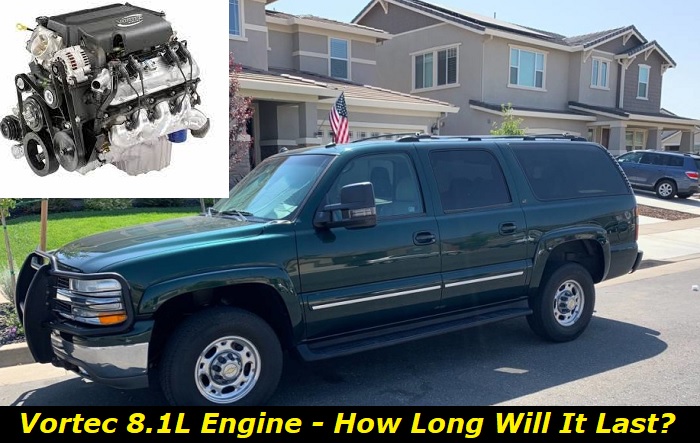General Motors Company is known for making indomitable engines that power all manner of vehicles. But of the myriad of engines it fixes in its own vehicles, the 8.1 Vortec engine stands out. This monster engine is regarded with awe by many and it has even been christened 'the big block of big blocks'.
In this article, we look at the 8.1 Vortec L18 engine, the features that make it stand out, and how long you should expect to enjoy using it. The engine which has been in production since 2001 and is also referred to as the Vortec 8100 is one of the heaviest in the engine lineup at GM. This makes it a better candidate for bigger vehicles such as the Chevrolet Express 2500, GMC Yukon XL 2500, GMC Sierra 3500HD, Chevrolet Kodiak, and Chevrolet Avalanche 2500.

Key features and my opinion about the engine
- Production years:2001-2009
- Average lifespan of Vortec 8100:300,000-400,000 miles
- Fuel supply type:port injection
- Power range:210-340 hp
- Fuel efficiency:awful
- Engine block material:cast-iron
- Engine reliability score:high
- The most common problems:oil pump problems, carburetor issues, low fuel efficiency, lots of minor problems.
Understanding the 8.1 Vortec
The 8.1 Vortec engine was introduced in 2001. It is a petrol engine that has a bigger block than the iconic 454. The engine came to replace the legendary 7.4L Vortec which remained in the market until 2001. The engine is also referred to as the 496 and its bore was based on the 454's 4.25". It, however, boasts a longer stroke which then makes the engine produce a whopping 496 cubic inches of displacement.
GM produced this engine to be ideally installed in full-size cars and trucks. The V8 engine was to be found in HD 2500/3500 series trucks. It was also to be found in commercial vehicles and vans. In 2007, GM retired the Vortec 8.1 thereby killing the last line of big-block engines found in trucks and SUVs. Remember the Vortec 7.4 ceased to be produced in 2001. In place of the 8.1L Vortec, GM started producing 6.2, 6.0, and 5.3 Vortec engines in 2008.
The features that make the Vortec 8100 L18 unique
The Vortec name has been around longer than many modern car brand names. In the mid-1950s, Vortec had the original 5.0L which was then followed by the 5.7L. In the nineties, with the introduction of the l4, l5, l6, and some V8 engines, the Vortec brand became a common brand name amongst motor vehicle owners. The 8.1 Vortec engine which powered thousands of vehicles around the world stayed with us for six years, until GM terminated its production.
Here are the leading features of the Vortec 8100 engine:
- The engine having been made by GM, a globally respected company, boasts an 8,128cc displacement which makes it a monster of power and a machine to behold.
- The V8 engine which is naturally aspirated comes with a maximum power of 330-340 Hp when the RPMs are at 4,200. But this output power varies from vehicle to vehicle, though the difference is not much.
- The engine is well known for its towing and hauling capacity. Between 1,000 and 4,000 RPM, the 8.1 Vortec will offer uniform power output.
- The maximum torque for the vehicle is between 440 and 455 lb/ft at 3,200 RPM. This feature is also vehicle-dependent. This V8 engine prides itself on having an incredibly flat torque curve.
- The engine is tough and designed to last long given that the manufacturer has used cast iron for the cylinder head as well as the engine block.
- The cylinder bore diameter is 4.25 inches which was the case for the Vortec 7.4. However, the extra power the 8.1 Vortec produces can be attributed to the long cylinder stroke length which reaches 4.37inches or 110.99 mm.
- The ignition and combustion processes are superior to the competition. The ignition is made so much more effective by the coil near plug technology and the platinum-tipped spark plug as well as the low-resistance spark plugs. The 2 valves per cylinder and the sequential multiport fuel injection make the combustion in this engine highly effective.
What are the common 8.1 Vortec L18 issues?
Of course, nothing is without a few issues. The 8.1 Vortec is no exception and users of the engine have time and again come forward to report common issues that bother the engine. Even having been touted as a stout engine, below are some of the issues to expect;
- Crankshaft piston failure
The 8.1 Vortec engine has a crankshaft position sensor that lets the ECU know what speed the crankshaft is running at. When this sensor fails, then the engine will not run. This problem though affecting all vehicles powered by this engine, the Chevy 8.1 seems to be affected the most. This issue is also characterized by the engine acting erratically and frequently shutting off.
The solution to the sensor is not a walk in the park either. The component is almost a foot long and reaching it is not easy. After unfastening it, it tends to get stuck. This then means that the engine's oil pan and the front suspension have to be removed first to create room to remove the sensor.
- Intake manifold gasket issue
Several car owners have reported failing gaskets which cause vacuum leaks. These leaks cause the engine to run rough and have poor idling. You should also notice a whistling sound from the engine and the general poor driveability of the car. The good thing about this issue is that the parts are relatively cheap and easy to find and with a little engine know-how, you can handle it yourself.
- Fuel economy
This is the elephant in the room. Most drivers of vehicles powered by this engine report a single-digit fuel economy. This is the case on the town roads. On the highway, the economy improves marginally to between 12 and 14 mph. This simply means that the 'big block' is thirstier than your average car. In most cases, this means your vehicle is ideal for utility rather than fun driving.
- Oil consumption issue
The 8.1 Vortec will burn an average of a liter of oil every 2,500 to 5,000 miles. If this goes unchecked, the engine might run low on oil and some serious internal damage may arise.
- Spark plugs issue
There is also the issue of the oil somehow getting into the cylinders hence being part of the combustion mixture. This leads to the spark plugs aging prematurely. It is recommended that you change the spark plugs of the engine every 25,000 miles.
- Lifter tick issue
Some drivers report that the lifter ticker sound that the 8.1 Vortec usually makes is annoying. To many drivers, this is not a big deal but for those that this ticking sound is annoying the solution is simple. Changing the oil to a heavier oil helps get rid of the lifter ticker. It is critical that you first establish whether the lifter ticker is being caused by some damage to an engine component before deciding to change to a thicker oil.
Lifters are located on the camshaft and are the ones that ensure that the valves open and close efficiently. The lifter tick noise can be caused by a number of reasons among them oil deposits, bent push rods, or a faulty lifter. In most cases, it is caused by oil deposits and that's why most drivers solve the issue by simply changing the oil.
How long will the 8.1 Vortec live
The Vortec 8100 engine has been installed on ordinary trucks and SUVs rather than on traditional muscle cars. It has been nicknamed the 'workhorse' in some quarters and this is true given the immense power it adorns. In many cases, the engine has been known to last well past 250,000 miles which is over 400,000 kilometers.
The reliability and the durability of the 8.1 Vortec engine depend on some factors such as the transmission it is coupled with. Alison transmission remains the most popular transmission. Like any other engine or machine, you can expect some issues but in this case, you have little to worry about. Earlier versions of the engine were dogged by the crankcase position sensor but over time, GM upgraded the engine to solve this issue. You can rest safe knowing the engine will almost never develop issues to make it fail.
The engine is made using cast iron and as such, it doesn't leave a lot of room for huge upgrades in horsepower capability. Still, this is one of the most capable engines out there, and with a massive 340hp and 450 torque, you are guaranteed to enjoy your drive anywhere. Moreover, the 550hp and 690 torque ratings mean the engine can most definitely tow just about anything you have in mind.
Conclusion
The 8.1 Vortec L18 engine is definitely a monster machine that boasts numerous capabilities. It is a reliable engine suitable for your tow rig. Some owners of the 8.1 Vortec have managed to swap the engine and tweak it to power their drag cars. The resulting drag car comes with serious capabilities.
The 8100 Vortec engine will easily give you 250,000 miles of service if you ensure regular service. The engine can easily give you 300,000 miles when you ensure regular wear and tear issues are sorted in time and also by practicing good driving behavior.
About the authors
The CarAraC research team is composed of seasoned auto mechanics and automotive industry professionals, including individuals with advanced degrees and certifications in their field. Our team members boast prestigious credentials, reflecting their extensive knowledge and skills. These qualifications include: IMI: Institute of the Motor Industry, ASE-Certified Master Automobile Technicians; Coventry University, Graduate of MA in Automotive Journalism; Politecnico di Torino, Italy, MS Automotive Engineering; Ss. Cyril and Methodius University in Skopje, Mechanical University in Skopje; TOC Automotive College; DHA Suffa University, Department of Mechanical Engineering






Add comment